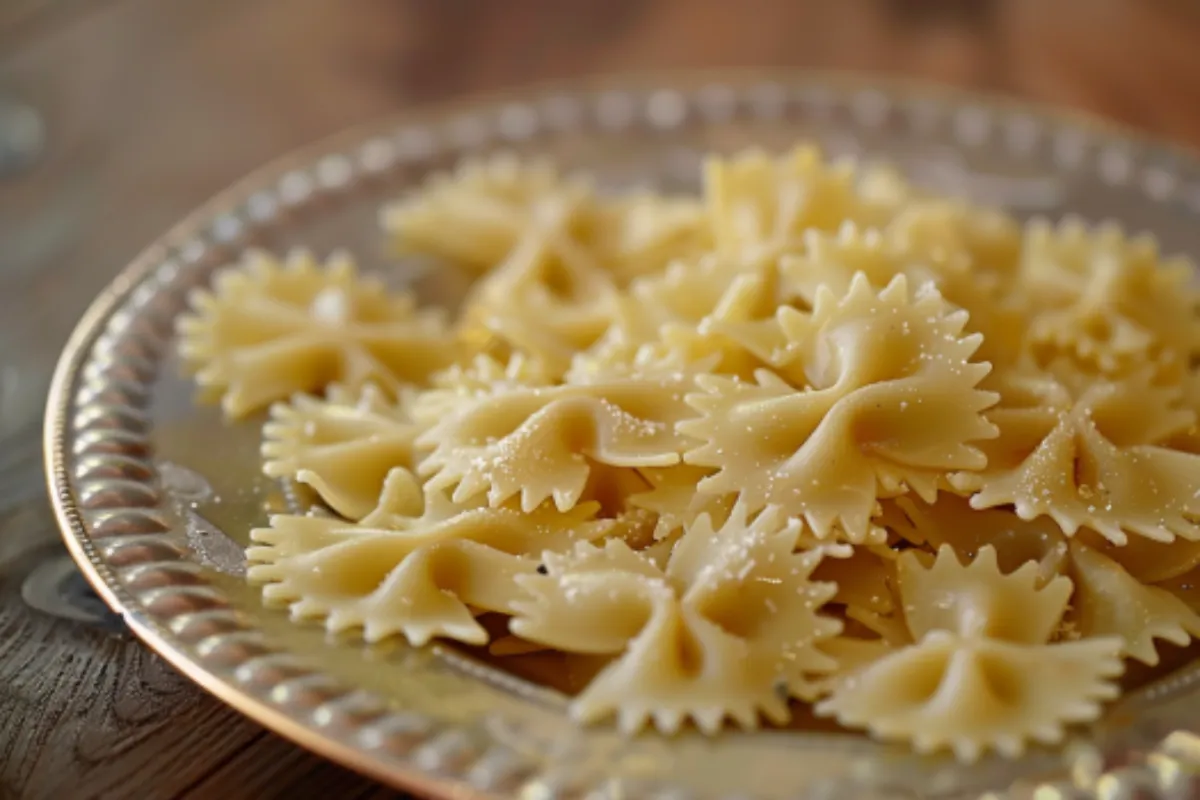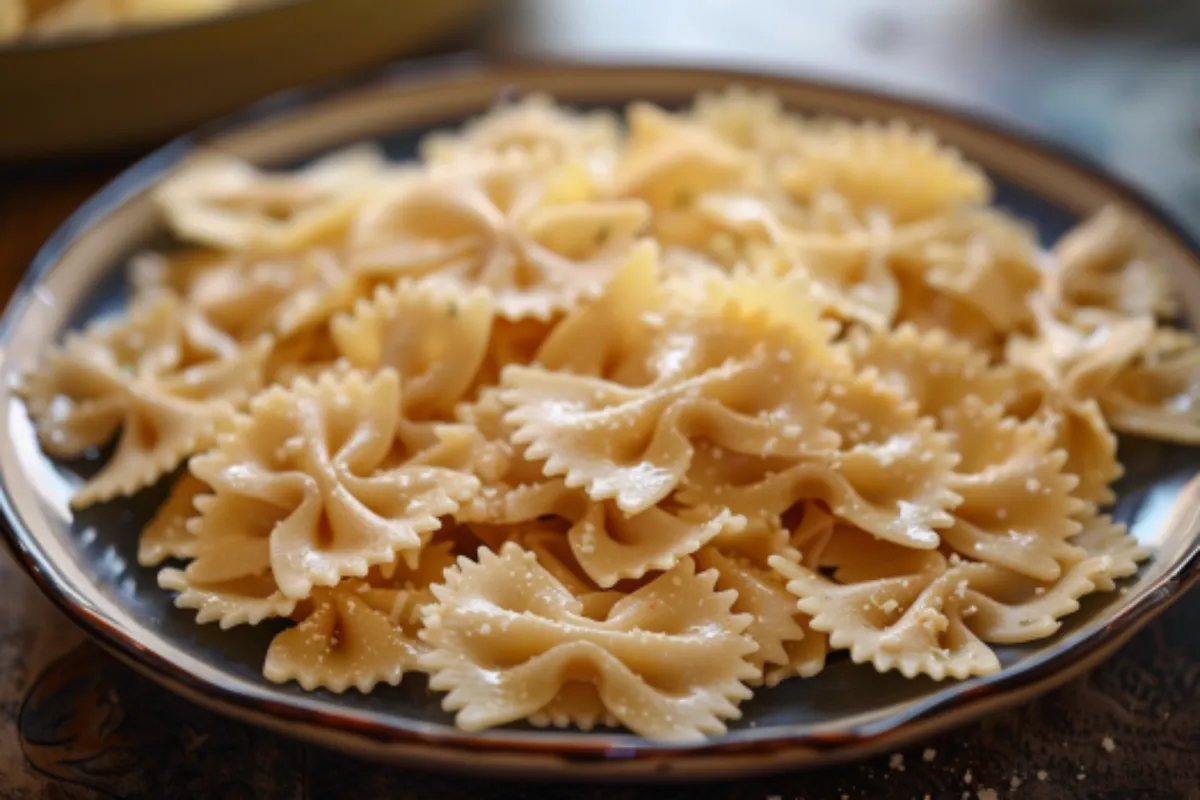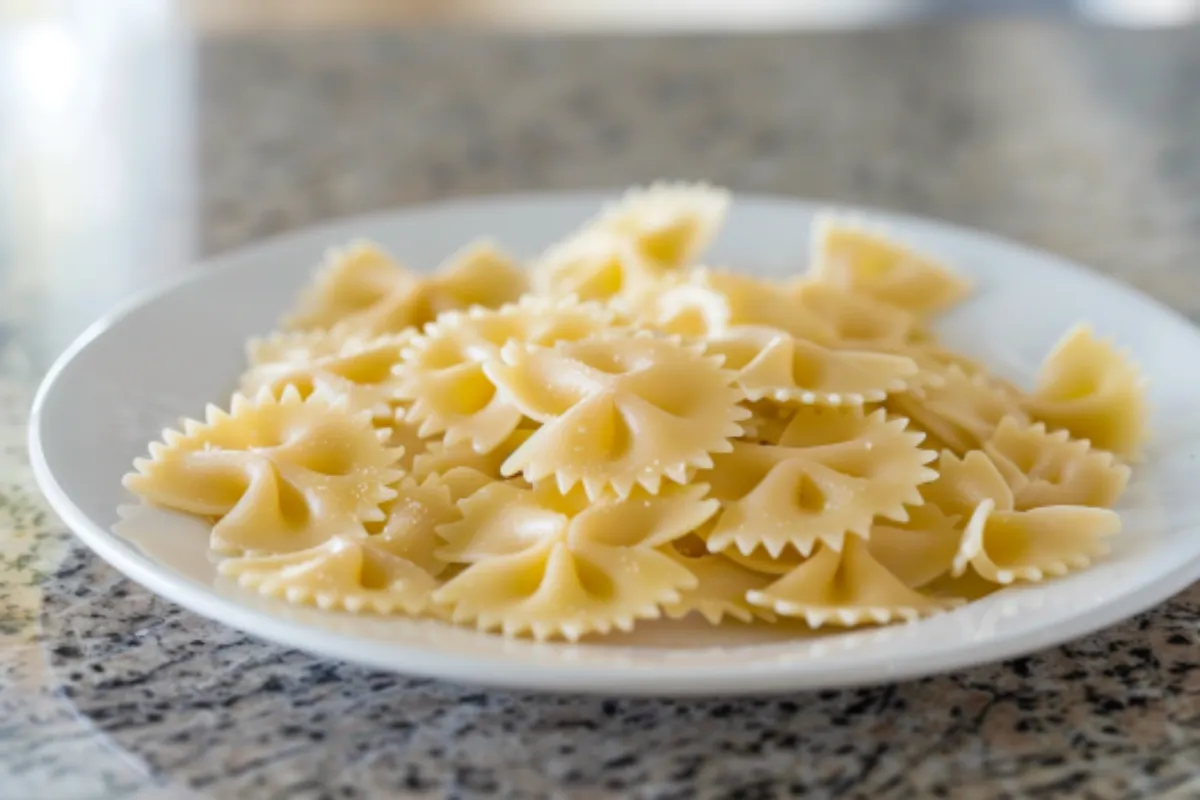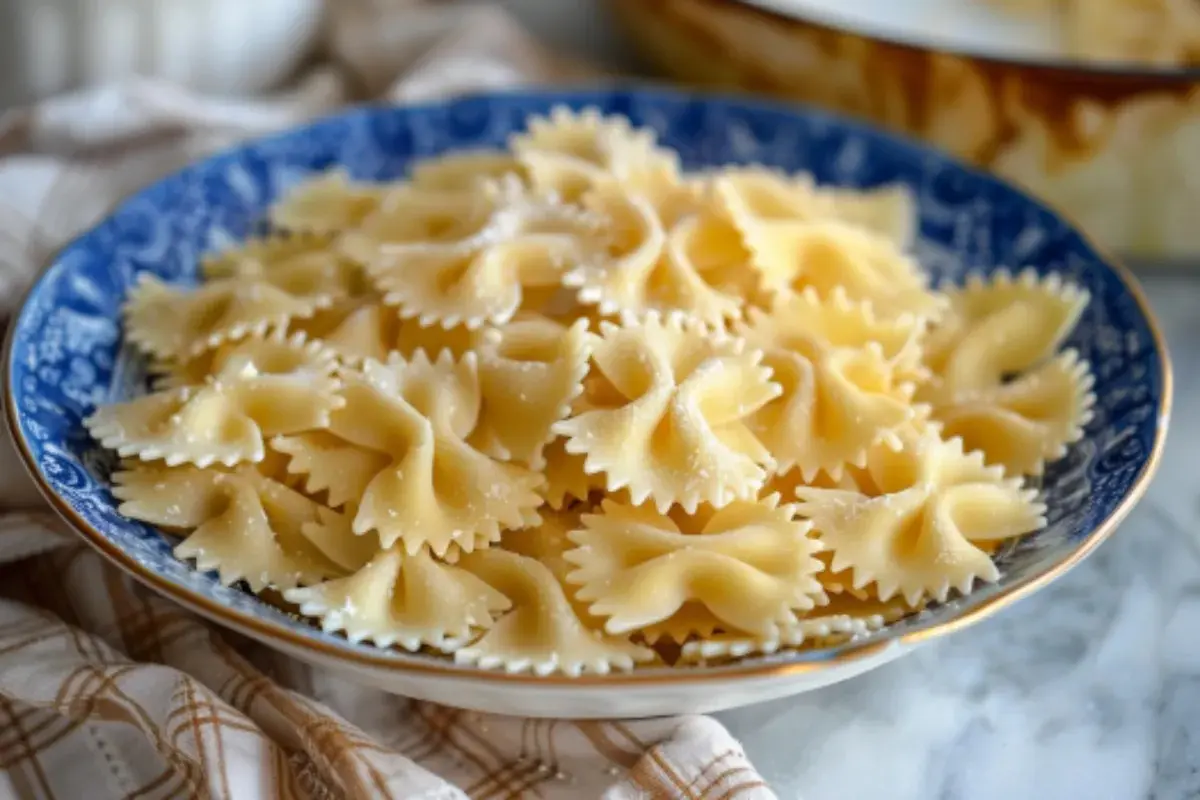Pasta is one of the most beloved and iconic foods globally, especially Italian pasta with its many shapes and sizes. Among the numerous varieties, farfalle pasta holds a special place due to its beautiful, butterfly-like appearance. But does farfalle really mean butterfly? The answer lies not just in the translation of the word but also in the shape, the history, and the cultural significance that come with it.
In this comprehensive article, we will explore the many facets of farfalle pasta. First, we will discuss its meaning and origins. Next, we will look at how it is used in Italian cuisine. Finally, we will examine its cultural symbolism. Additionally, we’ll take a look at the role of butterflies in Italian culture. We will also explore why this delicate shape continues to capture the imagination of chefs and food lovers around the world. This deep dive will leave you with a thorough understanding of how this humble pasta became an international star.
Does Farfalle Mean Butterfly in Italian?

The word farfalle comes from the Italian language and directly translates to “butterflies.” The name itself conjures images of delicate wings, a notion that clearly reflects the shape of the pasta. Each cook pinches the center of farfalle, creating flared edges that resemble butterfly wings. The beauty of this pasta shape lies in its simplicity and its functionality, making it both aesthetically pleasing and practical in cooking. Learn more about the history of pasta and its various shapes, like farfalle, that have evolved over time.
In English-speaking countries, people often refer to farfalle as bow-tie pasta due to its resemblance to the formal bow tie. However, this English nickname can obscure the pasta’s true origin and meaning. The Italian name is derived from the graceful insect, the butterfly, rather than an item of clothing. This distinction is important, as it not only reflects the visual design of the pasta but also ties it to a deeper cultural and natural significance in Italy. Learn more about how Italians use farfalle and other pasta shapes in their traditional dishes.
In Italian, the word “farfalla” refers to a single butterfly, while “farfalle” is the plural form, indicating multiple butterflies. This linguistic nuance further adds to the charm of the pasta. Each piece of farfalle can be seen as part of a larger collection of butterflies. They flutter together in a dish. Moreover, the connection between food and nature is strong in Italian culture. Farfalle pasta is a beautiful example of how language, art, and cuisine come together in a single concept.
Why the Shape Matters
The butterfly shape of farfalle is not just for show. In fact, it plays a functional role in how the pasta interacts with sauces and other ingredients. The pinched center of the pasta creates a texture that holds onto sauces well. Meanwhile, the wider edges provide a contrasting bite. They can trap bits of vegetables, meats, or cheeses. This versatility makes farfalle an ideal pasta for a variety of dishes. From rich and creamy sauces to lighter tomato-based preparations, farfalle fits perfectly.
But why butterflies? People have long associated butterflies with beauty, transformation, and grace. In Italy, many admire butterflies for their delicate elegance, and this reverence reflects in the design of farfalle pasta. By naming the pasta after butterflies, Italian cuisine pays homage to the natural world, where even something as simple as a pasta shape can evoke the wonder of nature.
Cultural Significance of Butterflies in Italy
In Italian culture, butterflies symbolize transformation, beauty, and lightness. Many see butterflies as creatures of grace, flitting about with elegance and poise. Artists and writers often use the symbolism of the butterfly, extending beyond its physical form. In Italian art, literature, and daily life, people use it as a metaphor for change and renewal.
For Italians, the butterfly reminds them of the fleeting beauty of life, something they should cherish and appreciate. This idea resonates with how Italians approach food and cooking; they view each meal as an experience to savor, much like the sight of a butterfly. This cultural symbolism is evident in the name farfalle, as the pasta brings a touch of whimsy and lightness to any dish.
Butterflies also appear in various Italian folktales and traditions, where storytellers often depict them as messengers of good fortune or symbols of the soul. This deeper cultural connection further enriches the experience of eating farfalle, as it invites diners to reflect on the artistry of Italian cuisine and the care that goes into every detail.
The History of Farfalle Pasta
Many trace the origins of farfalle pasta back to the northern Italian regions, particularly Emilia-Romagna and Lombardy. People know these regions for their rich culinary traditions, and local cooks have made farfalle a staple in their kitchens for centuries. The pasta was traditionally handmade, with cooks using a special technique to pinch the center of the dough, creating the distinctive butterfly shape.
While pasta is now often machine-made, the traditional method of making farfalle by hand is still practiced in some parts of Italy, particularly in artisanal pasta shops. This handcrafted technique not only adds to the charm of the pasta but also ensures that each piece is slightly unique, much like real butterflies in nature.
Historically, farfalle was created as a way to make use of leftover dough. Rather than letting the scraps go to waste, cooks would form the dough into small, butterfly-shaped pieces that could be dried and stored for later use. Over time, this practical solution evolved into a beloved pasta shape, celebrated for its versatility and beauty.
Farfalle Through the Ages
While the exact origins of farfalle are difficult to pinpoint, one fact is clear. Italians have enjoyed this pasta for hundreds of years. In the early days, it was often served with simple, rustic sauces. These sauces were made from local ingredients like tomatoes, garlic, and herbs. Over time, Italian cuisine became more refined. As a result, farfalle began to appear in more elaborate dishes. It was paired with rich sauces, fresh vegetables, and even seafood.
During the Renaissance, pasta-making techniques became more advanced, and farfalle began to be produced on a larger scale. The pasta’s delicate shape made it a favorite among the upper classes, who appreciated both its beauty and its ability to hold rich, flavorful sauces. As pasta became more accessible to the general population, farfalle quickly gained popularity across Italy and beyond.
Today, farfalle is enjoyed all over the world, and its butterfly shape has become instantly recognizable to pasta lovers everywhere. Whether served in a simple tomato sauce or as part of a more elaborate dish, farfalle continues to captivate the hearts (and taste buds) of people from all walks of life.
Culinary Uses of Farfalle: Butterfly Pasta in Modern Dishes

One of the reasons farfalle is so beloved is its versatility in the kitchen. The butterfly shape makes it an excellent choice for a wide range of dishes, as it pairs well with both light and heavy sauces. The pinched center of the pasta holds onto thicker sauces, while the wide, flared edges provide a delicate texture that works beautifully in lighter preparations.
Popular Dishes Featuring Farfalle
Farfalle can be used in both hot and cold dishes, making it a staple in many Italian kitchens. Here are some popular ways to enjoy farfalle:
- Pasta Salads: Farfalle is a favorite choice for pasta salads, as its sturdy shape holds up well when mixed with vegetables, cheeses, and vinaigrettes. The pasta’s unique texture also adds a delightful chew to cold salads, making it a popular choice for picnics and summer gatherings. Learn how to avoid common pasta salad mistakes with this pasta salad guide.
- Creamy Sauces: The pinched center of farfalle holds creamy sauces like Alfredo or Carbonara perfectly. The contrast between the soft, creamy sauce and the firm texture of the pasta creates a balanced bite in every mouthful.
- Tomato-Based Sauces: Farfalle pairs well with classic Italian tomato-based sauces like marinara or arrabbiata. The wide wings of the pasta allow the sauce to coat each piece evenly, while the center traps bits of sauce for added flavor.
- Pesto Dishes: Farfalle and pesto are a match made in heaven. The texture of the pasta complements the rich, aromatic flavor of fresh basil pesto, creating a dish that is both satisfying and flavorful. Whether you prefer a traditional basil pesto or something a bit more adventurous, farfalle is the perfect pasta for the job.
- Seafood: In coastal regions of Italy, farfalle is often paired with fresh seafood like shrimp, clams, or mussels. The lightness of the pasta works beautifully with the delicate flavors of the seafood, creating a harmonious balance of taste and texture.
Farfalle in Regional Italian Dishes
Different regions of Italy have their own unique ways of preparing farfalle. In the north, where the pasta originated, cooks often serve it with rich, creamy sauces. Chefs make these sauces from butter, cream, and local cheeses. In contrast, in the south, where tomatoes are abundant, cooks more commonly pair farfalle with lighter sauces. These tomato-based sauces showcase the flavors of fresh herbs and vegetables.
In Emilia-Romagna, for example, cooks traditionally serve farfalle with a rich, meaty ragù made from slow-cooked beef or pork. This hearty dish is a favorite during the colder months, as the thick sauce clings to the pasta, providing a comforting and satisfying meal.
In contrast, in the southern regions of Italy, chefs often feature farfalle in lighter, more summery dishes. A popular preparation involves tossing the pasta with fresh tomatoes, basil, garlic, and olive oil, creating a simple yet flavorful dish that highlights the natural sweetness of the tomatoes. This light and refreshing dish is a staple of southern Italian cuisine and is perfect for warm summer evenings.
Farfalle vs. Other Pasta Shapes: How Butterfly Pasta Compares
While many people love farfalle for its versatility and unique shape, it is not the only pasta that holds a special place in Italian cuisine. Italy is home to hundreds of different pasta shapes, each with its own distinct characteristics and culinary uses.
How Farfalle Compares to Other Pasta Shapes
- Fusilli: This spiral-shaped pasta is similar to farfalle in its ability to hold onto sauces. The twists and curves of fusilli trap sauces in a way that is similar to farfalle‘s pinched center. However, cooks tend to find that fusilli works best with chunkier sauces, whereas farfalle is more versatile and can be used in both light and heavy dishes.
- Penne: Penne is a tubular pasta that is often used in baked dishes or with thick, hearty sauces. While penne and farfalle can both handle rich, creamy sauces, penne’s shape makes it more suitable for dishes like baked ziti or pasta casseroles. Farfalle, on the other hand, is better suited to lighter, more delicate dishes.
- Rigatoni: Like penne, rigatoni is a tube-shaped pasta that is ideal for baked dishes. Its ridges help to hold onto sauces, making it a good choice for hearty ragùs and baked pasta dishes. However, rigatoni lacks the delicate texture and visual appeal of farfalle, which makes farfalle a better choice for more elegant, visually striking dishes.
- Tagliatelle: Chefs often use this flat, ribbon-like pasta in dishes that require a wide surface area for sauce. While cooks can use both farfalle and tagliatelle in creamy or tomato-based dishes, many associate tagliatelle with hearty, meaty sauces like Bolognese. Farfalle, on the other hand, offers more versatility and fits into a wider range of dishes.
Why Choose Farfalle?
While other pasta shapes may excel in specific dishes, farfalle stands out for its versatility and visual appeal. Whether you’re making a simple pasta salad or an elaborate seafood dish, farfalle adds both beauty and function to the plate. Its unique shape makes it a joy to eat, as each piece of pasta provides a different textural experience.
Moreover, the butterfly shape of farfalle is a reminder of the artistry and craftsmanship that goes into Italian cuisine. By choosing farfalle, you’re not just selecting a pasta shape you’re embracing a piece of Italian culinary history and tradition.
Farfalle in Modern Cuisine

In recent years, farfalle has become a popular ingredient in modern, innovative dishes. Chefs around the world have embraced the versatility of this pasta shape, using it in everything from fusion dishes to experimental culinary creations.
One of the reasons farfalle works so well in modern cuisine is its ability to adapt. It easily accommodates different flavors and textures. Whether you’re making a traditional Italian dish or experimenting with new ingredients, farfalle provides a solid foundation. Furthermore, it can be paired with a wide range of flavors.
Farfalle and Fusion Cuisine
Fusion cuisine, which combines elements of different culinary traditions, has become increasingly popular in recent years. Farfalle, with its neutral flavor and versatile shape, is a perfect canvas for fusion dishes.
For example, farfalle can be paired with Asian ingredients like soy sauce, sesame oil, and ginger. This combination creates a unique pasta stir-fry. Additionally, the butterfly shape of the pasta adds a playful element to the dish. Meanwhile, its texture provides a satisfying contrast to the bold flavors of the sauce.
In another example of fusion cuisine, farfalle can be used in Mexican-inspired dishes, such as taco pasta. By combining farfalle with traditional taco ingredients like ground beef, tomatoes, and cheese, you can create a fun and flavorful dish that blends Italian and Mexican culinary traditions. For more inspiration, check out this taco pasta recipe.
Frequently Asked Questions
1. What is farfalle pasta used for?
Farfalle is commonly used in a wide variety of dishes, from cold pasta salads to rich, creamy sauces. Its unique shape allows it to hold onto both light and heavy sauces, making it a versatile option for many different types of recipes.
2. Is farfalle the same as bow-tie pasta?
While people often refer to farfalle as bow-tie pasta in English-speaking countries, the term ‘farfalle’ comes from the Italian word for butterflies. The true inspiration for the pasta shape is the butterfly, not the bow tie.
3. Why is farfalle called butterfly pasta?
The word farfalle translates to ‘butterflies’ in Italian, and the shape of the pasta resembles the delicate wings of a butterfly. This name reflects both the visual design of the pasta and its cultural significance in Italy.
4. How is farfalle different from other pasta shapes?
Farfalle has a unique pinched center and wide, flared edges that make it ideal for holding sauces. This sets it apart from other pasta shapes like penne or fusilli, which have different textures and sauce-holding capabilities.
5. What is the best sauce for farfalle pasta?
Farfalle works well with both light tomato-based sauces and creamy sauces like Alfredo. The pasta’s shape allows it to hold onto the sauce, creating a well-balanced dish.
6. Can farfalle be used in pasta salads?
Yes! Farfalle is a popular choice for pasta salads, as its sturdy shape holds up well in cold dishes and provides a nice texture when mixed with vegetables, cheeses, and vinaigrettes.
7. How is farfalle made?
Traditionally, cooks make farfalle by rolling out sheets of pasta dough, cutting them into rectangles, and pinching the center to create the butterfly shape. Today, most producers make farfalle using machines, but some artisanal pasta makers still create it by hand.
8. What are some traditional Italian dishes featuring farfalle?
Chefs use farfalle in a variety of traditional Italian dishes, such as farfalle al pomodoro (farfalle with tomato sauce) and farfalle al pesto (farfalle with basil pesto). They also commonly pair it with seafood, meats, and vegetables in both northern and southern Italian cuisine.
Conclusion
In conclusion, farfalle is more than just a pasta shape it is a reflection of Italian culture, artistry, and tradition. Its butterfly-like form brings both beauty and function to the table. As a result, it becomes a versatile choice for a wide range of dishes. Whether you’re preparing a light pasta salad or a rich, creamy dish, farfalle adds a touch of elegance. Furthermore, it brings sophistication to every meal.
By understanding the meaning and history behind farfalle, you can gain a deeper appreciation for this beloved pasta. So, the next time you enjoy a plate of farfalle, remember this. You are not just eating bow-tie pasta. Instead, you are savoring a piece of Italy’s rich culinary heritage. And for more ideas on how to elevate your pasta dishes, check out this guide on how to jazz up your pasta.

